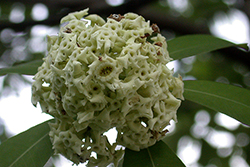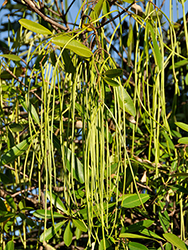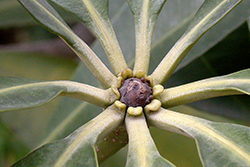e-Flora of Thailand
Volume 7 > Part 1 > Year 1999 > Page 45 > Apocynaceae > Alstonia
6. Alstonia scholaris (L.) R.Br.wfo-0001257712
Asclep. 65. 1810; Kurz, Fl. Burm. 2: 183. 1877; Hook.f., Fl. Br. Ind. 3: 642. 1882; King & Gamble, J. As. Soc. Beng. 74(2): 436. 1907; Ridl., Fl. Malay Penins. 2: 346. 1923; Pitard, Fl. Gén. I.-C. 3: 1164. 1933; Kerr, Fl. Siam. En. 2: 440. 1939; Corner, Ways. Trees 142. 1940; Monachino, Pac. Sci. 3: 146. 1949; Backer & Bakh.f., Fl. Java 2: 226. 1965; Whitmore, Tree Fl. Mal. 2: 11. 1973; Markgr., Blumea 22: 23. 1974; Tsiang & P.T.Li, Fl. Reip. Pop. Sin. 63: 90. 1977, Lý, Fedd. Rep. 97: 612. 1986; Li et al., Fl. China 16: 155. 1995.— Echites scholaris L., Mant. Pl. 1: 53. 1767.
Accepted Name : This is currently accepted.
Description : Tree to 40 m, to 75 cm diameter at breast height; bole often fluted. Bark brown, inner bark brown to yellow, sapwood whitish. Branchlets glabrous; branches sparsely to densely lenticellate. Leaves: petiole 7–14 mm long; in whorls of 4–8; blade coriaceous, elliptic, obovate or spathulate, 4.4–32 x 1.2–8.7 cm, apex shortly acuminate to rounded, base cuneate or decurrent; secondary veins 20–40 pairs, close together, straight; tertiary venation prominent above; glabrous. Inflorescence 3–8.5 cm long; pubescent; many flowered, clustered; pedicels ca 1 mm long. Sepals ovate, 1–1.9 x 1.5–2.3 mm, apex acute to rounded; pubescent, ciliate. Corolla white or yellowish green; lobes overlapping to the left in bud; tube 5.3–10 mm long; lobes 1.7–4.5 x 2–4.5 mm, elliptic, edges undulate; outside pubescent on top of tube and lobes, pubescent inside except at base of tube. Stamens inserted in upper half of corolla tube; anthers 1.1–2 x 0.4–0.6 mm. Disk very small and annular or absent. Ovary of 2 carpels, pubescent, 1.1–1.5 mm long; style + pistil head 2.8–5.2 mm. Fruit a pair of follicles, 21–56 cm long, 2–2.7 mm wide; glabrous; many seeded. Seeds glabrous; oblong, ends rounded; 3.9–7.5 x 1.4–1.9 mm, cilia 1.1–1.9 mm long.
Thailand : NORTHERN: Mae Hong Son, Chiang Mai, Chiang Rai, Phrae, Phitsanulok; NORTH-EASTERN: Loei, Udon Thani, Sakon Nakhon, Khon Kaen; EASTERN: Nakhon Ratchasima; CENTRAL: Lop Buri, Saraburi, Krung Thep Maha Nakhon (Bangkok); SOUTH-EASTERN: Chon Buri, Chanthaburi, Trat; PENINSULAR: Nakhon Si Thammarat, Trang, Satun, Yala.
Distribution : From India and Sri Lanka to S China, SE Asia, Malesia (type from Ambon), Queensland, Bismarck Archipelago and the Solomon Islands.
Ecology : In evergreen, deciduous or mixed forests, in scrub or on forests margins, 150–1,195 m alt.
Vernacular : Chaba (ชบา), phayasataban (พญาสัตบรรณ), tin pet (ตีนเป็ด)(Central); tin pet khao (ตีนเป็ดขาว)(Yala); ba-sa (บะซา), pu-la (ปูลา), pu-lae (ปูแล)(Malay-Yala, Pattani); sattaban (สัตบรรณ)(Central, Khmer-Chanthaburi).
Uses: The bark boiled in water is used to treat malaria and male genital pains. The sap can be applied to open sores to keep maggots out. The wood has similar properties to that of Alstonia angustiloba.



